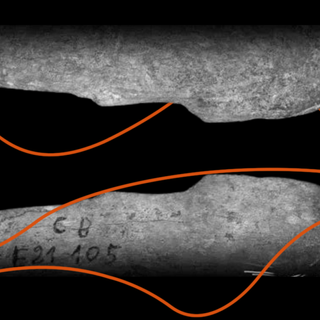Archaeologists recently discovered the earliest known cave art comes from the Quesang village in the Tibetan Plateau. Turns out, it was children who created the art. The drawings were fossilized on a piece of limestone called travertine.
Published in Science Bulletin, the research estimates the date of creation of this “art” — five handprints and five footprints — to be somewhere between 169,000 and 226,000 years ago. This makes the fossil predate other pre-historic art, from 43,900 and 17,000 years ago, which were, so far, considered among the earliest known cave art.
“About 200,000 years ago, ice age children squished their hands and feet into sticky mud thousands of feet above sea level on the Tibetan Plateau,” the Scientific American reported, adding: “These impressions, now preserved in limestone, provide some of the earliest evidence of human ancestors inhabiting the area and may represent the oldest art of their kind ever discovered.”
The researchers believe the child who made the footprints was aged around seven, and the one behind the handprints was about 12, based on present-day World Health Organization estimates.
That these impressions are simply the imprints of children’s limbs also raises an interesting question: do these creations qualify as art?
“Well, that depends on one’s definition, but the marks were deliberately made, and have a clear composition… [they] were not left during normal walking,” professors Matthew Robert Bennett and Sally Christine Reynolds from Bournemouth University, who co-authored the study, wrote in The Conversation.
Related on The Swaddle:
Cavemen Were Probably Hallucinating When They Painted on Walls, Research Says
But there’s another question the researchers don’t have a conclusive answer for: did the children even belong to our species — were they Homo sapiens? According to the researchers, they may belong to an extinct subspecies of archaic humans called Denisovans, who were present in Asia during a large part of the paleolithic period and mated with Homo sapiens. In the past, archeologists have also found their skeletal finds on the plateau, where they discovered the art.
But the Homo erectus, also extinct, was also known to inhabit the region. So, the researchers are not ready to rule out that the prints could also belong to their members.
“Denisovans are a real possibility… There’s lots of contenders, but no, we don’t really know,” Bennett told Live Science.
Despite these questions, what the art has provided is the earliest evidence of any hominin species existing at Quesang.
Further, this research adds to theories about children being some of the oldest artists in pre-historic times.
“Whatever these humble traces represent, they clearly evoke images of children at high elevations, enjoying a spot of creative play,” Bennett and Reynolds noted.




